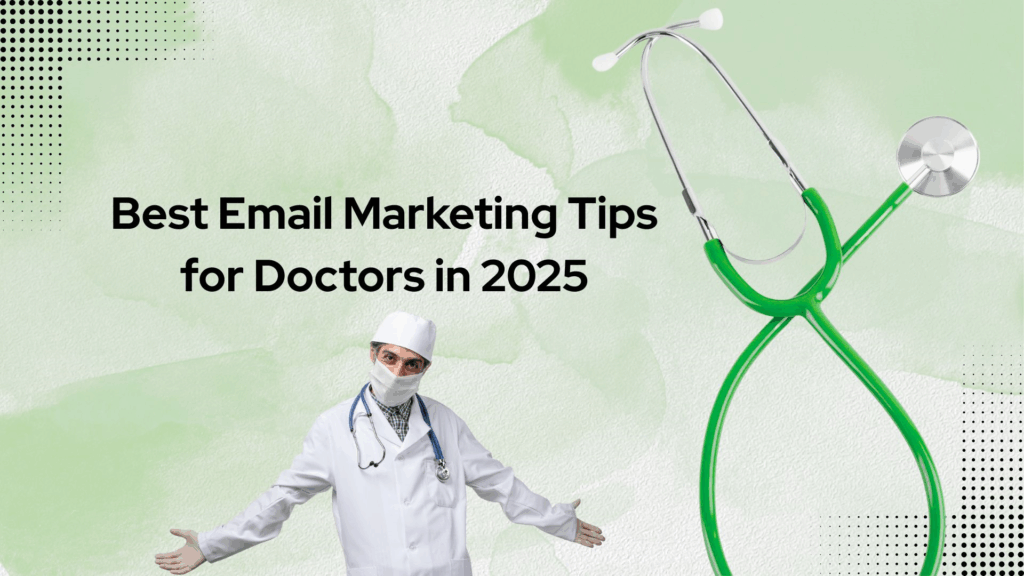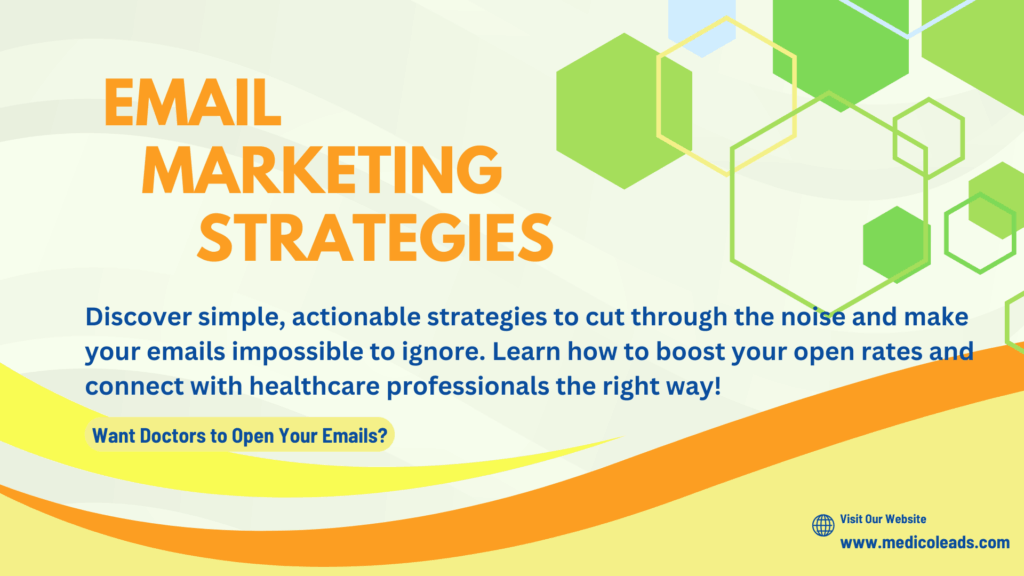Email allows doctors to receive important updates at their convenience, without interruptions, making it the preferred communication tool.

TABLE OF CONTENTS
Email remains one of the most powerful ways to get your message across—whether you’re reaching doctors or other busy professionals.
Whether you’re offering medical devices, continuing education, or relevant healthcare content, email provides a direct line to doctors, making it easier to deliver your message in a way that resonates with them.
In this post, we’ll explore how to leverage email marketing to build meaningful relationships, deliver high-value content, and drive conversions—while respecting the unique needs and busy schedules of healthcare professionals. By following these strategies, you’ll not only grab their attention but also foster trust, engagement, and long-term partnerships.

1. Why Doctors Prefer Email Over Other Communication Channels
Doctors have hectic schedules, and email makes life easier by letting them check important updates at their own pace, without the constant interruptions of phone calls or in-person meetings. Also, email lets them stay organized.
While email is definitely the go-to communication tool for doctors, it does come with its own set of challenges for marketers. Understanding these hurdles can help craft an email strategy that truly stands out in a crowded inbox and resonates with this busy group.
2. Key Challenges in Email Marketing to Doctors
Email marketing to doctors is powerful, but it also presents its challenges. Here’s a concise rundown of the key hurdles of targeting doctors via email:
- Cluttered Inboxes: Doctors get tons of emails daily, so your message needs to stand out with a compelling subject line and quick, relevant content.
- Time Constraints: With packed schedules, doctors don’t have time for long emails. Keep your message short, to the point, and easy to digest.
- Compliance Issues: Healthcare is heavily regulated. Make sure your emails are HIPAA-compliant and adhere to industry standards to avoid legal problems.
- Lack of Personalization: Generic emails are easily ignored. Segment your audience and personalize content based on specialties, previous interactions, and interests.
- Spam Filters: Doctors’ inboxes are full of spam filters. Focus on maintaining a clean email list and avoiding spammy language to improve deliverability.
- Low Engagement: Even if your email is opened, getting doctors to take action can be tough. Use clear calls to action (CTAs) and follow-up emails that deliver additional value.
- Content Overload: Doctors are already flooded with information. Your email must provide something unique, like time-saving tools or actionable insights.
- Mobile Compatibility: Many doctors check emails on mobile devices. Make sure your emails are responsive and easy to read on smaller screens.
- Information Overload: Don’t overwhelm doctors with too much content. Break up complex information into bite-sized, easy-to-follow emails.
- Building Trust: Doctors are cautious about unsolicited emails. Focus on delivering valuable content—like case studies or educational resources—to establish credibility and trust.
Now that we’ve covered the key challenges in email marketing to doctors, let’s explore some AI-driven strategies that can help you overcome these obstacles and create more effective, engaging campaigns.
3. Effective Strategies for Email Marketing to Doctors

Email marketing to doctors requires a blend of precision, personalization, and value. Here are some proven strategies that can help you reach and engage doctors more effectively:
3.1. Segment Your Audience
Doctors aren’t a one-size-fits-all group. Each specialty, practice size, and interest requires a unique approach. By segmenting your email list based on things like specialty, prior interactions, or interests, you can deliver more personalized content that speaks directly to their needs.
Example: A surgeon might care more about surgical tools, while a general practitioner needs different content, like patient care tips.
Looking to segment your audience easily?
We offer high-quality, customizable email. Start today with MedicoLeads—your go-to solution for targeted email campaigns!
Claim Your Free Sample3.2. Craft Compelling Subject Lines
Doctors are busy, so your subject line is everything. Make it short, clear, and directly relevant to what they care about. The goal is to show them the benefit of opening your email right away.
Example: “How This New Device Can Save You Time in the OR” or “Earn CME Credits with Our Free Webinar.”
3.3. Offer Value-Driven Content
Doctors want emails that actually help them—whether it’s improving patient care, staying updated on industry trends, or finding solutions to common challenges. Don’t just sell; share useful, educational content that brings real value.
Example: “5 Evidence-Based Ways to Improve Patient Outcomes” or “New Research on Treatment A for Condition B.”
3.4. Leverage Automation for Follow-Ups
Set up automated emails that follow doctors’ actions, like clicking on a product link or attending a webinar. This ensures they receive more detailed information or resources based on their interests.
Example: After attending a webinar, send a follow-up with the recording and additional resources.
3.5. Use Clear and Actionable CTAs
Your call-to-action (CTA) should be simple, direct, and easy to act on. Whether it’s scheduling a demo, downloading a free guide, or signing up for a webinar, make sure your CTA stands out and invites action.
Example: “Get Your Free Trial Today” or “Register for Our Free CME Webinar.”
3.6. Make Emails Mobile-Friendly
Doctors are always on the go, so many check emails on their phones or tablets. Ensure your emails are mobile-optimized—easy-to-read, with clickable buttons and simple design—so they can engage no matter where they are.
3.7. Personalize Your Emails
Nothing beats personalization. Use the data you have to address doctors by name and tailor content to their specialties or interests. This makes the email feel more like a conversation rather than a generic marketing pitch.
Example: “Dr. Smith, based on your interest in cardiology, we thought you’d find this study valuable…”
3.8. Timing is Key
Doctors have packed schedules, so think about when they’re most likely to check emails—early mornings or late afternoons are typically best. Experiment with timing, and consider sending emails during quieter parts of their day (like post-lunch) to increase open rates.
3.9. A/B Testing for Better Results
Don’t just guess what works—test it! A/B testing different parts of your email (subject lines, CTAs, visuals) helps you learn what resonates most with doctors. Over time, this improves your open rates and engagement.
3.10. Maintain Compliance
When emailing doctors, it’s critical to stay HIPAA-compliant and follow other regional healthcare regulations. Always prioritize privacy and security, especially if you’re dealing with sensitive patient data or medical content.
4. How to Measure the Success of Your Email Campaigns
To truly understand how well your email campaigns are performing, it’s important to track and analyze key metrics.
Measuring success goes beyond just open rates—it’s about understanding how your emails drive engagement, conversions, and ultimately, your business goals.
4.1. Here are the key metrics to focus on:
- Open Rate: The percentage of recipients who opened your email. This shows how effective your subject lines are.
- Click-Through Rate (CTR): The percentage of recipients who clicked on a link within your email. A good indicator of how compelling your content is.
- Conversion Rate: The percentage of recipients who completed a desired action (e.g., scheduling a demo, downloading content). This is your ultimate measure of success.
- Bounce Rate: The percentage of emails that didn’t reach the recipient’s inbox (either soft or hard bounces). A high bounce rate may signal issues with your email list.
- Unsubscribe Rate: The percentage of recipients who opted out of your email list after receiving an email. This shows if your content is resonating with your audience.
- Spam Complaints: The number of recipients who mark your email as spam. Too many complaints can harm your sender’s reputation.
- Forward Rate: The percentage of recipients who forwarded your email to others. This is a great measure of how shareable and valuable your content is.
4.2. Using AI to Improve Campaigns:
AI revolutionizes email marketing by automating metric analysis, spotting behavior patterns, and optimizing content for better engagement. It enables hyper-personalized emails tailored to each doctor’s needs.
With predictive analytics, emails land at the perfect time for maximum opens, while real-time optimization of subject lines and CTAs boosts effectiveness. AI makes campaigns smarter, faster, and more efficient, driving higher ROI.
5. Legal and Ethical Considerations When Emailing Doctors
When emailing doctors, you must follow legal and ethical guidelines to protect privacy and ensure confidentiality. Avoid spamming or sending unsolicited content. Always provide accurate, evidence-based information, and respect opt-out requests. Building trust and maintaining transparency are key to a successful and ethical email marketing strategy.
6. Conclusion: Start Email Marketing to Doctors with MedicoLeads
Email marketing to doctors offers powerful opportunities to build relationships and drive conversions, but success requires the right approach. By segmenting your audience, crafting compelling subject lines, offering valuable content, and using AI to optimize campaigns, you can improve engagement and ROI.
MedicoLeads makes it easy to segment your email list, ensuring you send relevant, personalized content to the right doctors. Get started to streamline your email marketing and see real results. Contact us today!
FAQ
What strategies work best when emailing doctors?
Focus on segmentation, personalized content, clear subject lines, and value-driven emails. Use AI for optimization and A/B testing for better results.
How do I stay HIPAA-compliant in email marketing?
Ensure your emails don’t contain sensitive patient data, use encrypted services, and follow privacy regulations.
What challenges do doctors face with email marketing?
Doctors deal with inbox clutter, time constraints, and information overload. Make your content brief and relevant to grab attention.
How can I segment my email list for doctors?
Segment by specialty, practice size, or interests to send more personalized, targeted content.
What kind of content should I send to doctors?
Send educational resources, industry updates, or time-saving tips. Focus on value, not just sales.
How does AI help improve email marketing?
AI helps with personalization, timing optimization, and real-time content adjustments, making your campaigns smarter and more efficient.
When is the best time to email doctors?
Typically, early mornings or late afternoons work best, but testing can help you find the ideal times.
How can I improve email open rates?
Craft compelling, relevant subject lines and test different options using A/B testing.
What metrics should I track for success?
Focus on open rates, CTR, conversion rates, and engagement to measure campaign success.
Which tools are best for emailing doctors?
MedicoLeads offers targeted email lists, while tools like Mailchimp and HubSpot optimize campaigns using AI-driven features.
How can I avoid being marked as spam?
Send personalized, relevant emails and maintain a clean email list to improve deliverability.
Contact Us
